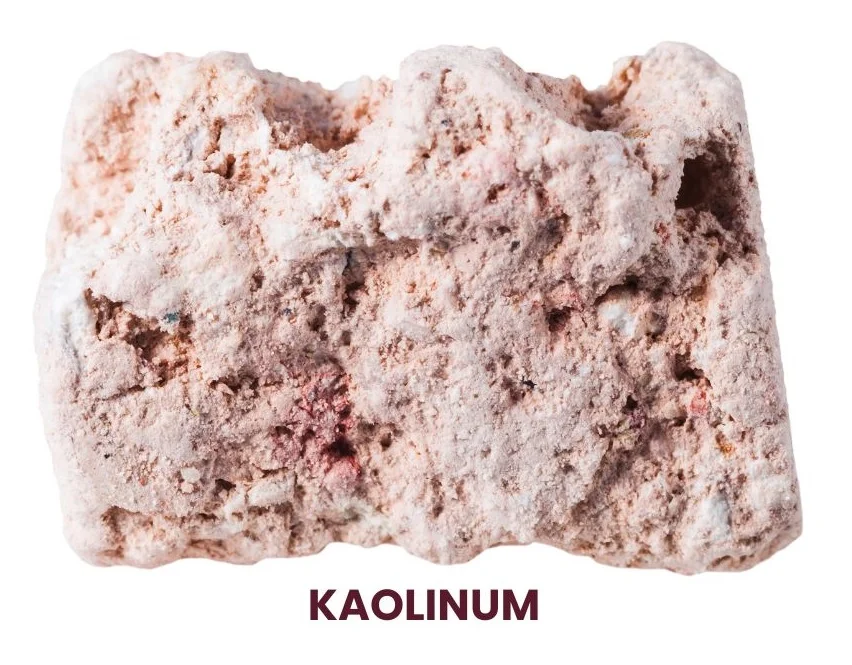Kaolinum, commonly known as China Clay or Kaolin, is a natural clay mineral predominantly composed of kaolinite.
It is widely used in various industries and is also significant in homeopathic medicine, particularly for treating respiratory conditions such as croup and bronchitis.

SOURCE INFORMATION
- Common Name: China Clay, Bolus alba
- Scientific Name: Kaolin (Alumina Silicate)
Scientific Classification
- Kingdom: Mineral
- Class: Phyllosilicates
- Group: Kaolinite-serpentine group
- Chemical Formula: Al₂Si₂O₅(OH)₄
Origin
- Kaolin is a type of clay found naturally in soils that have developed from the chemical weathering of rocks in hot, moist climates, such as those found in tropical regions.
- It is named after Kao-Ling (meaning “high ridge”), a hill in Jiangxi, China, where it was mined for centuries.
Historical Facts
- Kaolin has been used in China for over a thousand years, especially in the production of porcelain and ceramics.
- It was introduced to Europe in the early 18th century, leading to significant developments in the European porcelain industry.
- In homeopathy, Kaolinum was introduced for its medicinal properties in treating respiratory ailments and other conditions.
DRUG PATHOGENESIS
- Kaolinum acts primarily on the mucous membranes of the respiratory tract, alleviating inflammation and irritation.
- It is beneficial in conditions where there is soreness along the trachea and chest, often accompanied by specific types of sputum.
KEY CHARACTERISTICS
- Itching and burning sensation in the nose.
- Yellow nasal discharge.
- Soreness of the chest along the trachea.
- Grayish sputum in respiratory conditions.
- Effective in treating capillary bronchitis.
- Provides relief in cases of membranous croup extending down the trachea.
DETAILED ORGAN SYMPTOMS
NOSE
- Itching and Burning: Patients experience persistent itching and burning in the nasal passages, leading to discomfort and frequent rubbing of the nose.
- Discharge Yellow: The nasal discharge is typically yellow, indicating the presence of an infection or significant inflammation.
- Sore, Scabby, Stopped Up: The nose feels sore, with scabs forming inside the nostrils. There is also a sensation of being blocked up, making breathing through the nose difficult.
RESPIRATORY
- Soreness of Chest along Trachea: There is a distinct soreness along the chest, particularly along the trachea, making it painful to touch or press on the chest area.
- Cannot Stand Percussion: Patients find it intolerable to have their chest percussed (tapped), as it exacerbates the soreness.
- Gray Sputa: The expectoration (sputum) is gray, which is typical in cases of chronic bronchitis or other long-standing respiratory issues.
- Capillary Bronchitis: Kaolinum is effective in treating capillary bronchitis, where the small bronchial tubes are inflamed and filled with mucus.
- Larynx and Chest Sore: Both the larynx and chest feel sore, indicating inflammation and irritation.
- Membranous Croup: This condition is characterized by the formation of a membrane in the throat and trachea, leading to severe breathing difficulties.
- Kaolinum helps in reducing this membrane formation and alleviating symptoms.
MODALITIES
- Worse: Symptoms worsen with percussion (tapping) of the chest.
RELATIONSHIP WITH OTHER DRUGS
- Compare: Hepar Sulph (for similar respiratory conditions), Spongia (croup, respiratory affections), and Bromium (respiratory conditions with difficulty breathing).
DOSE
- Form: Lower triturations.
- Administration: Typically administered in homeopathic doses ranging from 3X to 6X potencies.
Frequently Asked Questions
What is Kaolinum used for in homeopathy?
- Kaolinum is primarily used for treating respiratory conditions such as croup, bronchitis, and other ailments characterized by soreness along the trachea and chest with specific sputum characteristics.
How does Kaolinum help in respiratory conditions?
- It alleviates inflammation and soreness in the respiratory tract, reduces mucus production, and helps in managing symptoms of bronchitis and croup.
What are the key symptoms that indicate the use of Kaolinum?
- Key symptoms include itching and burning in the nose, yellow nasal discharge, soreness of the chest along the trachea, grayish sputum, and intolerance to percussion of the chest.
Glossary of Difficult Words
- Alumina Silicate: A type of compound containing aluminum, silicon, and oxygen.
- Bronchitis: Inflammation of the bronchial tubes, often resulting in coughing and mucus production.
- Capillary Bronchitis: Inflammation of the smallest bronchial tubes.
- Croup: A condition characterized by a barking cough and difficulty breathing, often due to inflammation around the vocal cords.
- Membranous Croup: A severe form of croup where a membrane forms in the throat, causing breathing difficulties.
- Percussion: A medical examination technique that involves tapping on the surface of the body to diagnose underlying conditions.
- Sputum: Mucus that is coughed up from the lower airways.
This detailed drug picture of Kaolinum provides a comprehensive understanding of its sources, uses, and symptoms it can treat, making it a valuable remedy in homeopathy for specific respiratory ailments.
